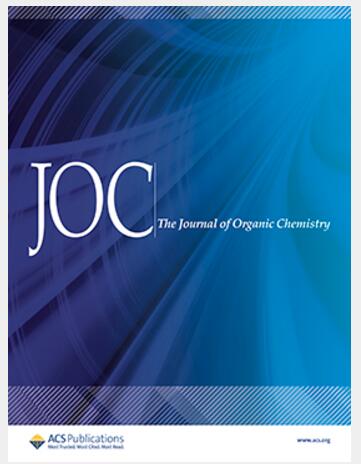精确调控及构效关系下端氟吩咪唑的合成。
IF 3.6
2区 化学
Q1 CHEMISTRY, ORGANIC
引用次数: 0
摘要
设计具有适当的电荷转移(CT)或局部激发(LE)比的杂化局部和电荷转移(HLCT)分子通常需要仔细考虑。为了探索CT与LE在苯并咪唑体系中的合适混合比例,本研究将不同数量的氟原子精确调控并引入到末端苯环上。以非苯咪唑为供体,不同量的氟苯为受体(0F-mP、1F-mP、2F-mP、3F-mP),成功设计合成了一系列D-A型分子。研究结果表明,所设计的四种分子均具有HLCT特性,理论计算和实际实验均证实了这一点。在C4位置引入氟显著影响了相关的光物理性质:增加了光致发光量子产率(PLQY),缩小了半最大全宽度(fwhm),有效地减少了Stokes位移。1F-mP在THF溶液和固态中的plqy分别为50.8%和50.4%。然而,1F-mP在大多数溶剂中表现出更高的PLQY和不变或更窄的fwhm,这表明适当的CT/LE比调节可以显着影响其光物理性质。本文章由计算机程序翻译,如有差异,请以英文原文为准。
Synthesis of Fluorine-Terminated Phenanthrimidazole under Precise Regulation and Structure-Activity Relationship.
Designing hybrid local and charge transfer (HLCT) molecules with an appropriate charge transfer (CT) or local excited (LE) ratio often requires careful consideration. To explore the suitable mixing ratio of CT and LE in the phenanthroimidazole system, in this study, different numbers of fluorine atoms were precisely regulated and introduced onto the terminal benzene ring. A series of D-A type molecules were successfully designed and synthesized using phenanthrimidazole as the donor and varying amounts of fluorobenzene as the acceptor (namely, 0F-mP, 1F-mP, 2F-mP, and 3F-mP). The research results show that the four types of molecules designed demonstrate HLCT characteristics, as confirmed by theoretical calculations and varying the practical experiments. The introduction of fluorine at the C4 position significantly affects the relevant photophysical properties: increasing the photoluminescence quantum yield (PLQY), narrowing the full width at half-maximum (fwhm), and effectively reducing the Stokes shift. The PLQYs of 1F-mP in THF solution and solid states are 50.8 and 50.4%, respectively. However, 1F-mP exhibits a higher PLQY and either unchanged or narrower fwhm in most solvents, which indicated that the appropriate CT/LE ratio regulation could significantly affect the photophysical properties.
求助全文
通过发布文献求助,成功后即可免费获取论文全文。
去求助
来源期刊

Journal of Organic Chemistry
化学-有机化学
CiteScore
6.20
自引率
11.10%
发文量
1467
审稿时长
2 months
期刊介绍:
Journal of Organic Chemistry welcomes original contributions of fundamental research in all branches of the theory and practice of organic chemistry. In selecting manuscripts for publication, the editors place emphasis on the quality and novelty of the work, as well as the breadth of interest to the organic chemistry community.
 求助内容:
求助内容: 应助结果提醒方式:
应助结果提醒方式:


